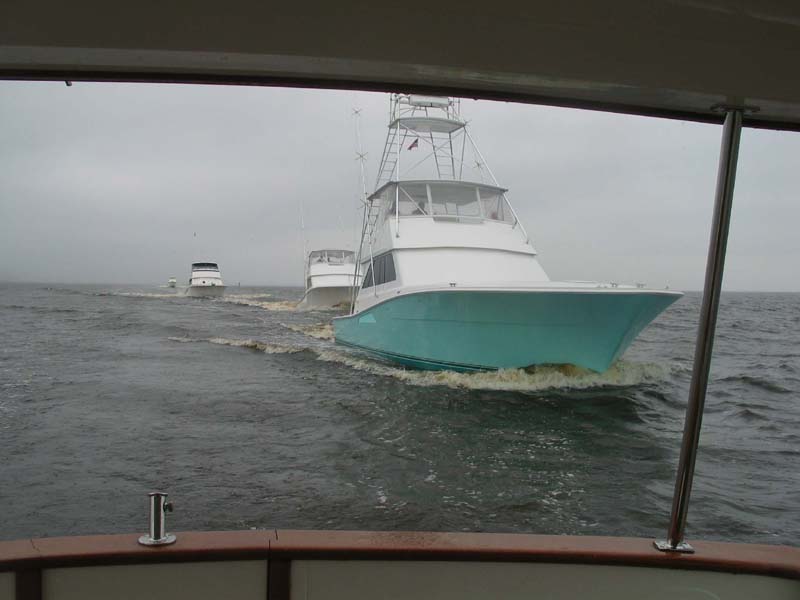
After the locks we entered the North Landing River and the Currituck Sound, where we were passed by schools of large sportsfisherman boats. Why? Well it turns out that we happened to be migrating south for the winter with most of the fast boats of New England and New York. These large boats cost millions and are 50-60 feet long. They go 20-30 knots and push a lot of water. This water rolls our boat a lot. The nice captains slow down and talk to us on the radio. The not-so-nice captains just fly by and cause all of our dishes and glasses to smash into each other. Fortunately Erich's boat has stabilizers which greatly reduce the rolling, but even with stabilizers we still can get trounced.
Trawler Note: My next trawler will definitely have stabilizers. Powered fin stabilizers are much more useful than paravanes (a.k.a. "flopperstoppers"). Paravanes are nice but when the conditions require it, deploying the paravanes is too risky, so they are never used. Contrast this with stabilizers: press a button and they instantly limit the rolling.

After the sound we entered Coinjock Bay and then hunkered down for a rainy night at the Coinjock Marina. It was the closest we ever were docked to a store: about 10 feet from the door of the store. Here I stocked up on more Diet Pepsi.
Cruising Note: Very few stores are close to boats. When you are near one, use it to stock up on the heavy stuff, like water, drinks, ice, canned goods, etc., so you do not have to carry things so far.

The rain reminded me of Seattle! It was nice. Notice that we caught up to the green sportfisherman. We ended up seeing many boats over and over.
Cruising Note: Staying at marinas in a canal, like here at Coinjock, is different than at regular marinas. Each marina (one on each side of the canal) simply has one long dock along its side of the canal. All of the boats were lined up bow to stern along the dock. When you arrive they direct you to go in front of the previously docked boat, and then they pull you back and tie you up with about one foot between boats. Getting out the next morning required the frontmost boat to leave first, then the next, etc. We were ready to roll by 6:45 AM but had to wait until after 8 AM due to the boats around us. The marina across the canal filled up partially, but our marina was completely filled up by dusk. At busy/popular places like Coinjock, arrive early to get a spot.
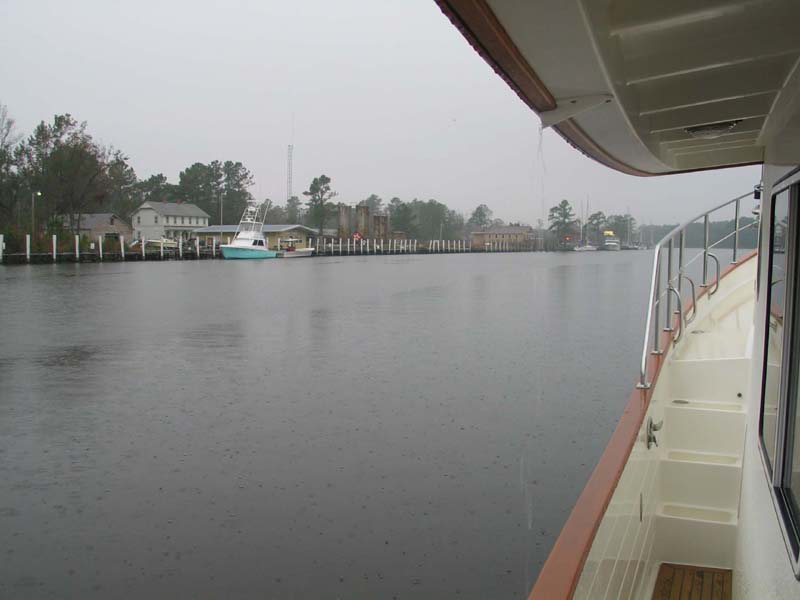
We stayed in Coinjock because they have a famous restaurant. We went to it but neither of us got the 32 ounce prime rib that they are known for. Interestingly enough, the tables full of people that came in from the sportsfisherman boats were all eating the 32 ounce cuts of beef! We got a nice waitress who had never waited on customers before. She was 19 years old and nervous to the point that Erich had to catch a glass that would have otherwise fallen. She is going to a local junior college in the daytime. We learned that the attendant in the Coinjock Marina store was also 19 and going to the junior college. He was considering joining the Coast Guard. It was fun to talk to these people and see what they wanted to do with their lives.
After dinner we returned to the inviting warmth of the Dogger. I slept on the floor or the couch in a sleeping bag. The boat's interior is kept about the same temperature as the water, or about 55°F in Coinjock. Captain Erich used the forward master stateroom.

The next day we continued to be passed by large, fast boats...
Cruising Note: Each boat is legally responsible for its wake. If a boat throws a big wake and the wake damages local docks or whatever, the owner is responsible. I came up with a neat method to get large boats to slow down: stand on the back of our boat as they approach and take pictures of them, especially of their stern which shows their name and hailing port. I think they realized that they could be tracked down and dunned for any damage so they proceeded more cautiously.Big boats can throw small wakes and small boats can throw big wakes. It turns out that fast passes are often better than mid-speed passes for the Krogen 39. A slow pass is of course best. The important thing was for us to get behind the passing boat as quickly as possible so to be in the dead zone rather than to be hit by the waves expanding to the sides.

I like the nice wood on this boat!
Cruising Note: Teak requires a lot of work to keep looking nice.

Recognize this boat? It was the boat ahead of us at the first bridge. It is interesting how we were like the tortoise versus the hares. Many of the fast boats passed us over and over. They would not go as far each day as we would.
Cruising Note Be nice to the other boats. This pays off in the long run as often you will interact with them again!

These lines were my responsibility as first mate. We used one each on the bow and stern, and two as spring lines.
Cruising Note: The docks in the north part of this trip do not float up and down and your lines must be rigged in such a way that they can handle the 1-3' tides. Also, few docks have cleats; instead lines must be tied around vertical posts. Sometimes two boats share a post and then the lines become intertwined. Rope work in the east is different than in the west! The tides get larger in South Carolina and Georgia (up to 8') and they have more floating docks.
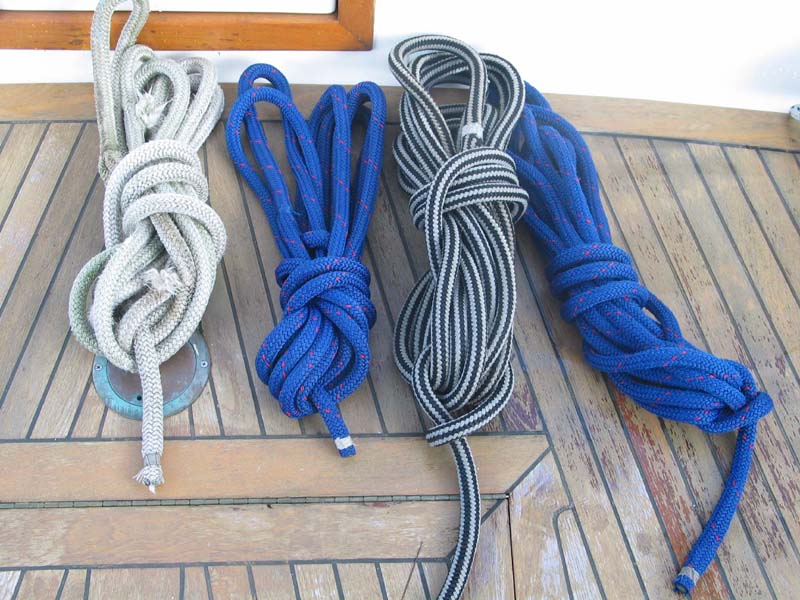
The next day cleared up and we had a wonderful day crossing the Albermerle Sound which is quite a large body of water. This swing bridge is at mile 84.2 of the ICW. 18 nmi east of here is Roanoke Island where Sir Walter Raleigh established the first English colony in America in 1587.
Book Note: While we crossed this body of water I read Lee Miller's Roanoke: Solving the Mystery of the Lost Colony which was great fun to read while being right in the area. This first English colony mysteriously disappeared after a few years, but this author shows that the colony in fact dispersed into the neighboring area and ended up intermingling with the local native American Indians. She also argues that local politics back in England were against Sir Walter Raleigh's endeavor and fought to prevent the colony from being rescued and resupplied. The book covers a lot about England in the 1580s and 1590s. It reads almost like a novel.
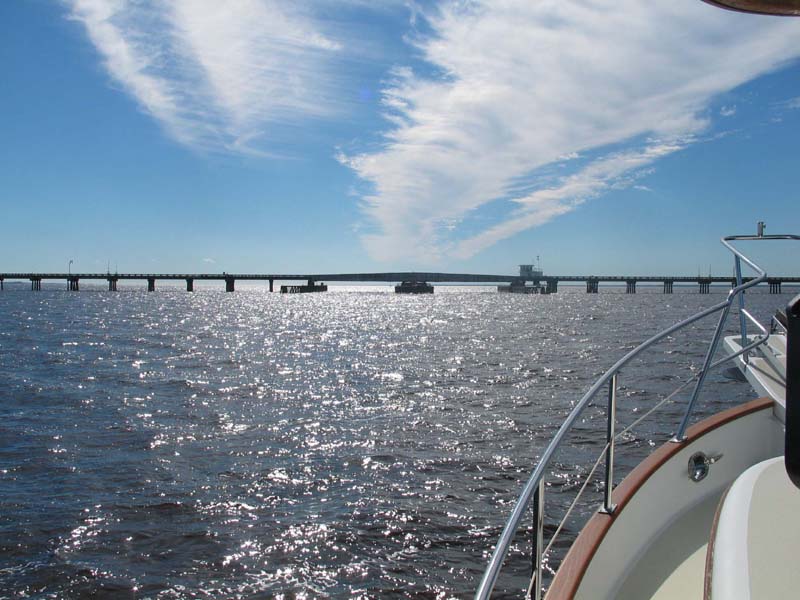
The ICW transits bays, sounds, and rivers, but when there was no natural body of water the Army Core of Engineers built their own bodies of water. When we got to the end of the Alligator River and needed to get to the Pungo River, we then turned into this, the longest canal of the ICW, the 22 mile Alligator River-Pungo River Canal. What a project!
Cruising Note: Started here and there in the 1890s, the main ICW was built in the 1930s. It is supposed to be 12 feet deep the entire 1095 miles, but there are places where it is only 6 feet deep. Deep keel sailboats have to be very careful or they will run aground. We saw several sailboats grounded on the trip, waiting for high tide to lift them off. We never hit bottom with our 4' 3" draft, but we saw 6' of water a couple of times, which is a bit unnerving.The boat that just passed us ended up throwing a huge wake that rolled us a lot. Say, what in the heck is in the middle of the canal up ahead? An island?

No, it is not an island. It appears to be a tug pushing something.

A large metal something.

A large metal something with a guy sitting on the front of it! He waved to me. He apparently was a lookout with a radio back to the tug.

Oh, I see now: it is a floating Navy power station! We actually passed it twice, and it came through Coinjock in the night travelling very slowly, with lots of large searchlights. We called it "the floating city". What a weird contraption! The ICW has a variety of traffic indeed.
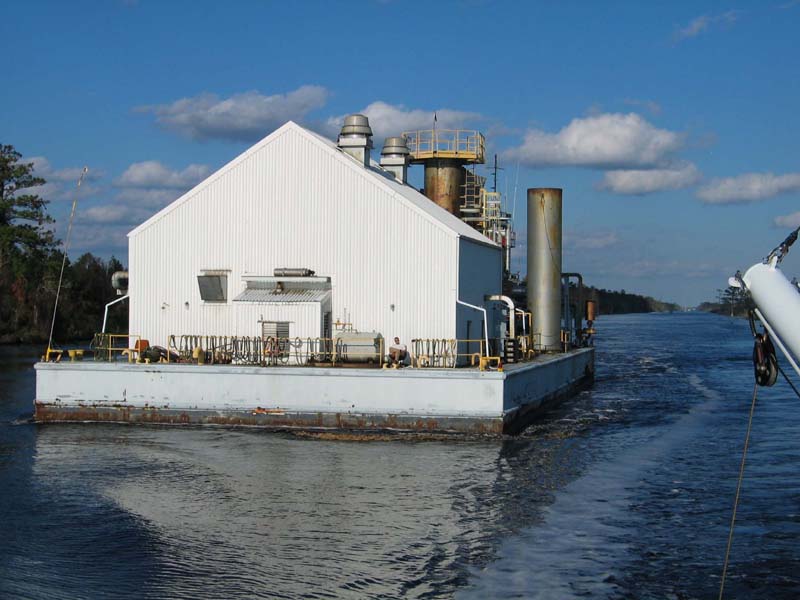
Time to get passed again by another fast boat. We really travelled with the sailboats more than with the power boats due to our speed. We talked to one of the large sportsfisherman and he said that he burned 60 gallons of fuel an hour. We burned 1.5 gallons per hour. In fact, the fuel for our entire trip was only about 200 gallons, less than $300.
Locale Note: Note the "tea-stained" water splashing up in this photo. It comes from tannin found in the 35 species of oak trees found in the South. The water looks like this from North Carolina through northern Florida. Tannin is poisonous and is in acorns. This is why acorns need to be boiled before eating them, as boiling removes the tannin.

Captain Ringewald at the helm of the Dogger.
Trawler Note: In the foreground is a Furuno 1731MKIII radar, then behind it is a Garmin GPS162 usually left in a large map view, then there is the primary Simrad CP32 GPS which is left in a data display mode. The Simrad drives the next instrument, a Robertson AP22 autopilot. Then behind the nice Hynautic engine controls is a Dell Latitude laptop running Nobletec's Visual Navigator. Up above from left to right is the FM radio, weather telex and stabilizer controls (all out of the photo), then a B&G wind indicator, a B&G depth and speed indicator, then an Icom M-127 VHF radio which we used constantly, and finally an ICOM M-710RT SSB radio which when used causes the boat's autopilot to initiate a turn!
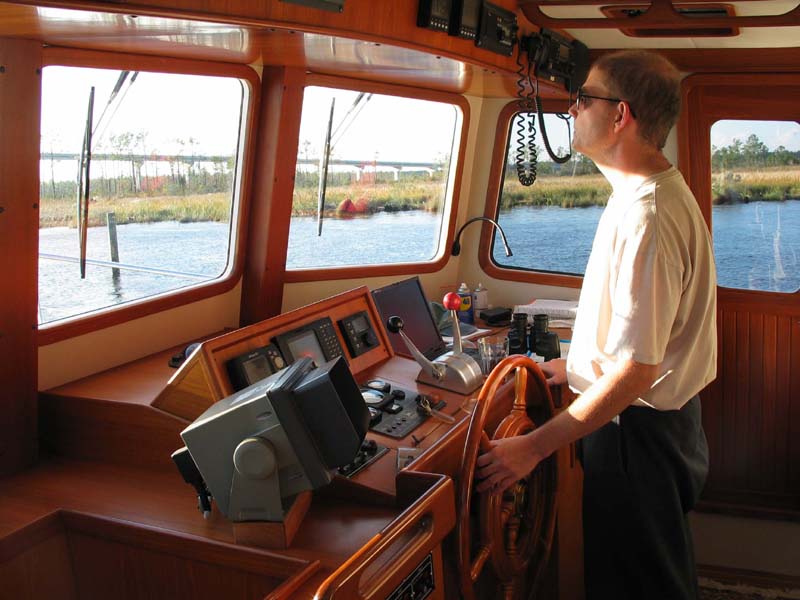
Almost to the end of the Pungo canal! One must plan one's day so that the entire canal can be transited, as there is no place to anchor or dock for the night in the 20-odd miles. The end of our long afternoon in the canal is just after the Wilkerson Bridge up ahead at ICW milepost 126.
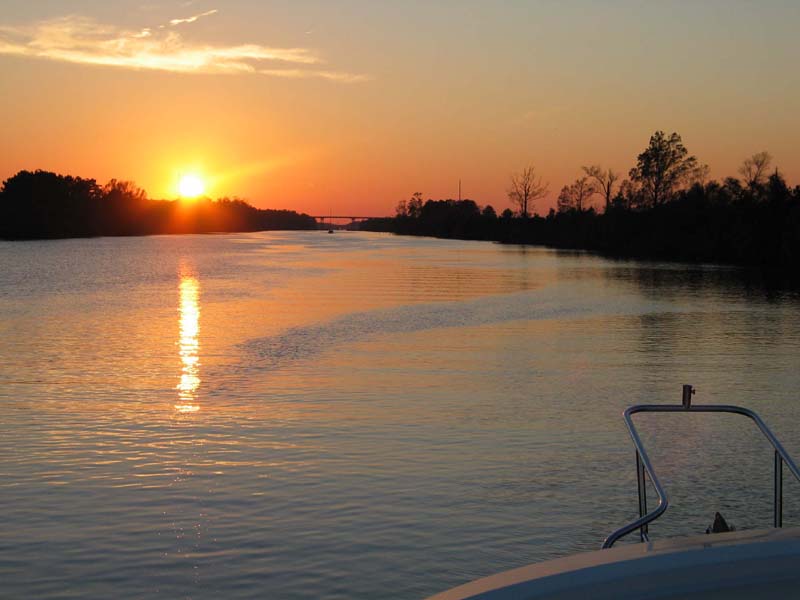
We anchored at ICW milepost 127, along with other boats. Beautiful sunsets were a delight of the trip.
Food Note: We had a caesar salad, fried asparagus, and quesadillas for dinner shortly after anchoring. We had this meal a lot, to our mutual satisfaction. I even got adventurous and put the asparagus on my salad by the end of the trip, following Erich's lead.
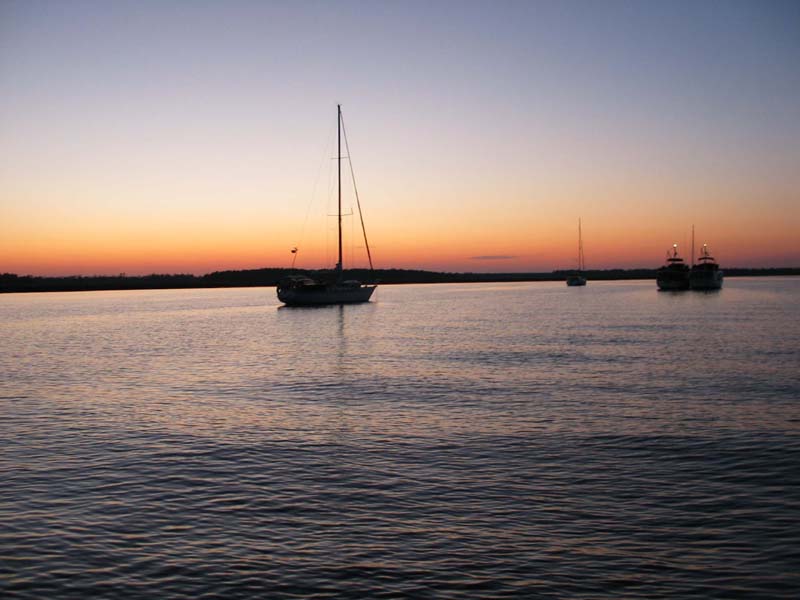
Last updated: 2003.11.21.